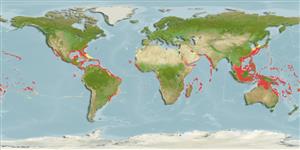Elasmobranchii (hajar och rockor) (sharks and rays) >
Carcharhiniformes (Ground sharks) >
Carcharhinidae (Requiem sharks)
Etymology: Carcharhinus: karcharos (Gr.), sharp or jagged; rhinus, an ancient name for sharks, from rhine (Gr.), rasp, both words alluding to a shark's jagged, rasp-like skin. (See ETYFish); galapagensis: -ensis, Latin suffix denoting place: Galapagos Islands, type locality. (See ETYFish).
Environment: milieu / climate zone / depth range / distribution range
Ekologi
marina revassocierade; djupintervall 1 - 286 m (Ref. 58302), usually 30 - 180 m (Ref. 37816). Tropical; 36°N - 34°S, 180°W - 180°E (Ref. 55181)
Circumtropical with a preference for waters around oceanic islands. Eastern Atlantic: including St. Paul's Rocks (Refs. 13121, 52289). Western Indian Ocean: including Walter's Shoal, south of Madagascar. Western Pacific: including Middleton and Elizabeth Reefs. Eastern Pacific: Galápagos (Ref. 58896).
Length at first maturity / Size / Vikt / Age
Maturity: Lm 230.0, range 215 - 245 cm
Max length : 370 cm TL hane/ej könsbestämd; (Ref. 1602); common length : 300 cm TL hane/ej könsbestämd; (Ref. 9253); publicerad maxvikt: 85.5 kg (Ref. 40637); rapporterad maxålder: 24 år (Ref. 31395)
Taggstrålar i ryggfenan (totalt): 0; Mjukstrålar i ryggfenan (totalt): 0; Taggstrålar i analfenan 0; Mjukstrålar i analfenan: 0. Low inter-dorsal ridge present (Ref.9997). Dark grey above, light below, fins plain or with slightly dusky tips (Ref. 9997).
A common but habitat-limited tropical shark found close inshore to well as offshore near or on insular or continental shelves (Ref. 244). Prefers clear water with coral and rocky bottoms (Ref. 244). Although a coastal pelagic species, it is capable of crossing considerable distances of open ocean between islands (at least 50 km) (Ref. 244). Juveniles restricted to shallower water, in 25 m or less (Ref. 244; 37816). Found in superficial aggregations (Ref. 244). Tends to feed near the bottom but may take bait from the surface (Ref. 5485). Feeds mainly on bottom fishes, also squid and octopi (Ref. 244). In the Galapagos Is. it preys on sea lions and marine iguanas (Ref. 28023). Inquisitive and sometimes aggressive, displaying a 'hunch' position ( arched back, raised head and lowered caudal and pectoral fins, while twisting and rolling) near divers that may be followed by biting (Ref. 58085). Viviparous (Ref. 50449). 6 to 16 young of 57 to 80 cm are born per litter (Ref. 1602).
Viviparous, with a yolk sac placenta (Ref. 244). 6 to 16 young born at 60-80 cm (Ref. 26346). Distinct pairing with embrace (Ref. 205).
Compagno, L.J.V., 1984. FAO Species Catalogue. Vol. 4. Sharks of the world. An annotated and illustrated catalogue of shark species known to date. Part 2 - Carcharhiniformes. FAO Fish. Synop. 125(4/2):251-655. Rome: FAO. (Ref. 244)
IUCN Red List Status (Ref. 130435)
Threat to humans
Traumatogenic (Ref. 4690)
Human uses
Fiskeri: mindre kommeriell
Ytterligare information
referenserVattenbrukVattenbruksprofilAvelslinjerGenetikElectrophoresesÄrftlighetSjukdomarBehandlingNutrientsMass conversion
MedarbetareBilderStamps, Coins Misc.LjudCiguateraHastighetSimsättGälytaOtolithsHjärnstorlekSyn
Verktyg
Special reports
Download XML
Internet-källor
Estimates based on models
Preferred temperature (Ref.
123201): 15 - 28.2, mean 23.8 °C (based on 1899 cells).
Phylogenetic diversity index (Ref.
82804): PD
50 = 0.5000 [Uniqueness, from 0.5 = low to 2.0 = high].
Bayesian length-weight: a=0.00479 (0.00221 - 0.01036), b=3.09 (2.92 - 3.26), in cm total length, based on LWR estimates for this Genus-body shape (Ref.
93245).
Trofisk nivå (Ref.
69278): 4.2 ±0.4 se; based on diet studies.
Generation time: 8.8 ( na - na) years. Estimated as median ln(3)/K based on 1
growth studies.
Resiliens (Ref.
120179): Mycket låg, lägsta populationsfördubblingstid mer än 14 år (Fec=4).
Fishing Vulnerability (Ref.
59153): High to very high vulnerability (73 of 100).
Nutrients (Ref.
124155): Calcium = 3.97 [0.89, 21.70] mg/100g; Iron = 0.329 [0.083, 0.941] mg/100g; Protein = 22.1 [19.2, 24.4] %; Omega3 = 0.0987 [, ] g/100g; Selenium = 46.8 [14.0, 139.5] μg/100g; VitaminA = 39.1 [13.8, 112.6] μg/100g; Zinc = 0.504 [0.236, 0.958] mg/100g (wet weight);
